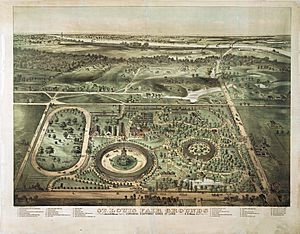Saint Louis Exposition facts for kids
The Saint Louis Exposition, also known as the St. Louis Expo, was a big series of yearly fairs. These events showed off new ideas in farming and technology. They happened in St. Louis, Missouri, at a place called Fairground Park. The fairs ran from the 1850s until 1902.
In 1904, a much larger event, the Louisiana Purchase Exposition, which was a huge World's Fair, took place in St. Louis. Because of this, the yearly St. Louis Expo paused in 1903 and 1904. It never started up again after the World's Fair. Sometimes, old items from the yearly St. Louis Expositions get mixed up with souvenirs from the 1904 World's Fair.
Contents
History of the St. Louis Expo
How the Fair Began
In 1855, a group of people from St. Louis started an organization. They called it the "St. Louis Agricultural and Mechanical Association." This group began holding yearly fairs in 1856. Important citizens founded this association. They did not plan to make money for themselves. Instead, any money earned was used to make the fairgrounds bigger and more beautiful.
The Association bought a large piece of land. It was about 50 acres (200,000 m2) in size. This land was located at the corner of Grand Avenue and Natural Bridge Plank Road. At that time, it was far outside the city. It took about an hour to get there by horse and carriage. They built the biggest amphitheater in America there. It could seat over 12,000 people, with even more standing room.
What You Could See at the Fair
The yearly fair was a big hit right away. It quickly became famous across the country. It was like a giant county fair. There were booths selling food and drinks. You could see displays of farm animals like livestock and poultry. There were also fresh vegetables and grains. People showed off the newest farm machines, tools, and home gadgets.
Many buildings were built for the fair. These included the amphitheater, a mechanical hall, and an agricultural hall. Other buildings were the floral hall and a fancy Gothic fine arts hall. There was even a three-story "Chicken Palace" for showing off different kinds of poultry. Besides the exhibit halls, there was a racecourse, a grandstand, and a jockey club.
The Fair During the Civil War
In 1860, the fairgrounds were opened to the public for picnics. People could visit for a small fee. However, the fairs soon stopped for a few years during the Civil War. The fairgrounds were used by the military for training. The large amphitheater was turned into a hospital. It became one of the biggest and best-ventilated hospitals in the United States. It could hold 2,500 patients. Many other fair buildings were used for soldiers' living areas, medical places, and kitchens. After the war ended, the park went back to being used by the Association.
A Zoo Joins the Fairgrounds
In 1876, a zoological garden was added to the fairgrounds. It was designed like the best zoos in Europe. It had a monkey house, bear pits, and a house for meat-eating animals. Later, they added a birdhouse, outdoor areas for plant-eating animals, a lake, and a grotto. These animal exhibits and buildings later became part of the St. Louis Zoo when it was created.
In 1893, the fairgrounds became even larger. They grew to about 143 acres (0.58 km2). In 1902, the first car race in St. Louis was held on the grounds.
The Fair's End
The last official St. Louis Exposition was held in 1902. This was because everyone was getting ready for the huge 1904 World's Fair. The yearly fair did not start again after 1904. Another reason the fair did not return was that horse racing was stopped in Missouri in 1905. Horse racing had been a big part of the fair.
From Fairgrounds to Park
A New Park for St. Louis
After a lot of discussion, the city of St. Louis bought the old fairgrounds. The land was about 132 acres (0.53 km2) and had been left empty. The city paid $700,000 for it in 1908. The land was bought to be used as a public park. Fairground Park was officially opened on October 9, 1909. All the old fair buildings and zoo structures were removed. Only the bear pits from the old zoo and the amphitheater were left.
What Remains Today
In 1912, the amphitheater was also removed. It was replaced by the city's first public swimming pool. At the time, people said it was the biggest pool in the world. This pool was replaced by a new one in 1958. This was part of a city plan that also added lighted baseball fields and hard tennis courts.
Today, at the corner of Grand and Natural Bridge, you can still see the front of the old bear pits. It looks like a medieval castle. It stands as a reminder of the exciting days of the popular St. Louis Exposition.


